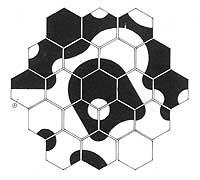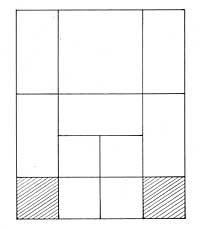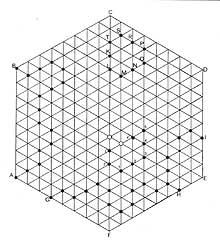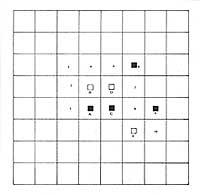Some games

The first game is called hexagonal dominoes, as their chips must be tied as in the domino game. This game consists of nineteen regular hexagons. These hexagons are the same size, but they are all of different drawings. (See image). The game consists of forming another large hexagon with differences of three hexagons with nineteen hexagons, as shown in the figure.
Nineteen hexagons must be properly combined on all sides, black, white and white and black with black and white.
The game can be developed in several ways, depending on the number of players. Only a player can play as solitaire or forming images (in the image you see the window and the moon in the center, but the Napoleonic hat, etc. ). They can also be completed). Since each tab (except A) has its own negative or symmetrical color, symmetrical images can also be formed. You can play as in dominoes with two or three players. In this case the move will start with the hexagon that is split by a straight (tab A). The other eighteen hexagons are mixed and distributed among the players. The player who finishes the game or all the chips (or the player who has the least chips in his hands when it cannot be longer) will win. There may also be a tie.
A question about this game. Can you complete a black image, for example, completely continuous? When we show that black is in four groups and ask to put one in one. Try to complete it.
The second game also has to do with the hexagon. The game board is hexagon. This hexagon consists of many equilateral triangles (see figure). Players must equip the game board with numerous chips, such as stands. There are two players with chips of one color or type each. For example, some grains of wheat and some of wool. The tiles will be placed alternately at the vertices of the triangles.
The play can be won in three different ways:
- Linking two vertices of the major hexagon. For example, link points A and B only with the individual tab with a line. Linking three sides of the large hexagon. Linking points G, H and I by one line (either G, H, E or I, F, since vertices E or F represent two-sided).
- When you get a closed polygonal line with at least one vertex inside. For example K, L, M, N, O, P, R, S, T, once the closed line is completed. In this case there are three vertices within the closed line, where there can be chips.
The draw can also be achieved in two ways: either when the two players agree or fill all vertices.
Now we have to make a note. When we use the word link, it means that the pass tabs of one hexagon vertex linked to another, or from one side to the other, must be placed at the successive vertices, and at the vertex of the pathway we must only find tokens of the same color or type. This path can be long enough. Path 1, 2, 3, 4, 5 of the image is good for joining points 1 and 5, but path 1, 2', 3', 4' 5 no.

The third game is Chinese and although some can play at the same time, it is also appropriate to play alone. The pieces of this set are made of wood or plastic, as you have to slide against the bat. So do the parts correctly. The pieces will move within a rectangular frame of suitable dimensions.
The pieces are ten: a large square, four vertical rectangles (each with the middle of the square), a rectangled rectangle (the size of the others) and four small squares (half the size rectangles). The pieces are placed at the beginning as seen in the image, leaving two gaps free. With two holes, the pieces move by sliding them.
The game consists of replacing the large square with four small squares and the small square with a large one. To do this, the four rectangles cannot be laid or those that are lying can be raised.
In the original game there is a poem written about the pieces (one or more words per piece) and once the change is obtained another poem can be read.
Finally, we will save you in the table of 64 squares like chess. Only two players (or two teams) can participate. You need 64 matching tiles of two colors. Each tile will have a white and a black face or two colors. Players will choose a color that will be placed facing up. The person who has selected the white color should put their 32 tiles with the white face up. The 64 tiles will be rotated in the table following rules:
- The first four chips (2 white and 2 black) will be placed in the four central boxes as chosen by the players (A,B,C,D).
- Once the first rule is completed, the remaining tiles will be placed as follows: each tile (for example, the black one) will be placed next to a (blank) tile of the opposing player; in the same row or column or diagonally in squares 1, 2, 3, 4, 5, 6, 7 or 8. In addition, the tab (black) will be placed on the same line (row, column, diagnosis) of another tab of the same color, remaining between them and without gaps one or more tiles (blank) of the opposite. In box 10 for example you can not put black but yes in the 11. For example, A, C, 11 forms the row and A, D, 6 the diagonal.
The intermediate piece(s) of the chain (white(s)) will be captured and turned around; the white will become black.
In this way the whole chain (along with the ends) will be the color (black) of the extreme tiles.
- If multiple strings are formed when you locate a tile, all of them will be returned. The opposite tiles (white) can only be captured when the same tile (black) is placed. The chains captured otherwise, with the tab returned, do not return.
- The play will end when the 64 chips have been placed or no one can put more, winning the one with more chips of their color in the table.
If a player can't put any tiles by following the rules, he will lose his turn (give him way) until he can locate any tiles.
Note: Placed tiles cannot be moved or removed, but can be changed as many times as necessary.







